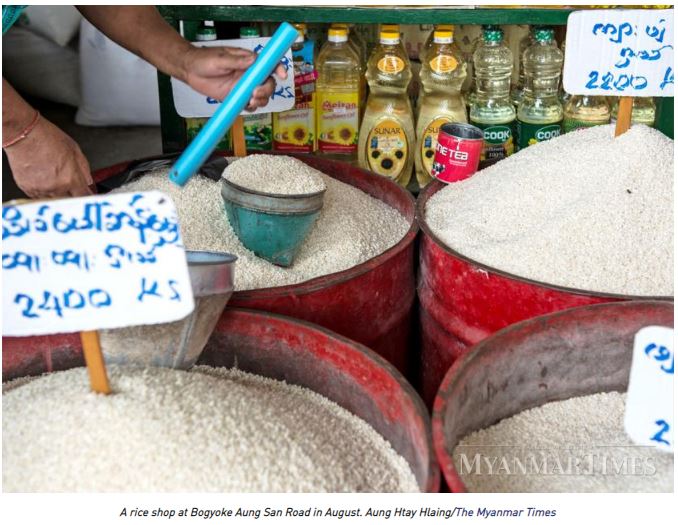Myanmar: Domestic rice prices hit record levels
The price of high quality domestic rice has risen the most in five years, driven by rising demand, inflation and potential price manipulation, local traders said.
According to data from the Myanmar Rice Federation and Myanmar Rice and Paddy Traders Association, a bag of Ayeyarwady Paw San rice had hit K52,000 in August, which is up by almost 60 percent since the start of the year. Meanwhile, a bag of Shwebo Paw San rice cost K62,000 in August, up nearly around 35pc over the same period.
On the other hand, the prices of lower quality Ei Mahta and broken rice, which are mainly exported, appear to be stable, officials from Myanmar Rice and Paddy Traders Association said.
U Aung Than Oo, chair of the association, told The Myanmar Times that the price of Paw San rice is actually at its highest since 2014 and that the sudden spike in prices is “unusual. Prices weren’t this high last year when supply was scarcer. This could represent changing consumer demands in favour of higher quality rice,” he said.
Cornered market?
Yet, there could also be some price manipulation involved. According to U Aung Kyi Soe, a rice agent, “the bigger and richer farms, merchants and rice mills are cornering the market by going to the rural areas and buying up all the Paw San rice. After calculating the paddy price, they will name the price at which they want to sell processed rice to agents, which is driving up the price,” he said.
In general though, paddy prices have been rising due to inflation. In Myanmar, the increase in the price of rice is tied closely to paddy prices. Currently, Ayeyarwady Paw San paddy is trading at around K1.3-K1.4 million per basket. “As prices of other commodities rise, it also impacts the price of staple food, which is rice,” said U Nay Lin Zin, joint-secretary of the Myanmar Rice Federation.
During this monsoon season, more than 16 million acres of monsoon paddy were planted. However, more than 300,000 acres of paddy fields have been destroyed due to floods in the recent months, resulting in more volatile prices.
Since then, 100,000 acres has been replanted, so the floods are not expected to affect this year’s paddy production rate, said U Myo Tint Tun, deputy permanent secretary of the Ministry of Agriculture, Livestock, and Irrigation.
Exports earnings
Things are more stable on the export side. As Myanmar exports only lower quality rice, the spike in price of Paw San rice has not affected the export market, said U Than Oo, secretary of Bayintnaung Rice Wholesale Center.
“The export market is stable even though the domestic rice market has obviously been rising. There is no high demand for Myanmar rice from China so far so prices seem to be stable,” said U Than Oo.
At 800,000 tonnes between April and July, rice export volumes are so far lower by around 100,000 tonnes compared to the same period last year, according to the Myanmar Rice Federation.
Source: https://www.mmtimes.com/news/domestic-rice-prices-hit-record-levels.html


 Thailand
Thailand




